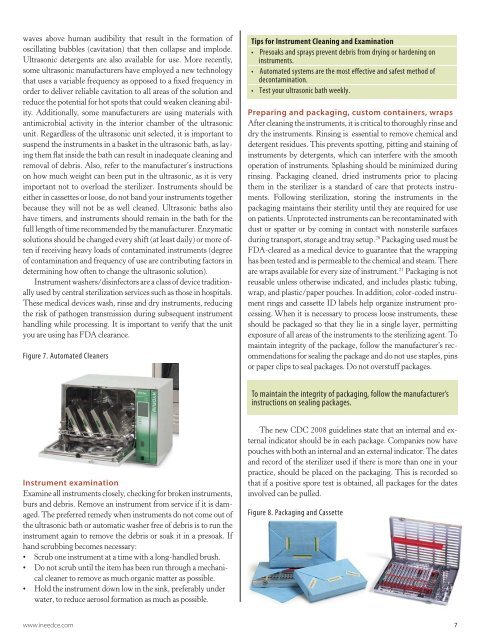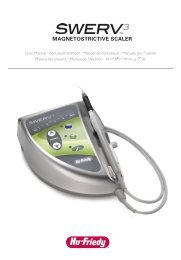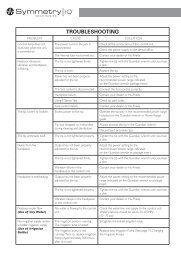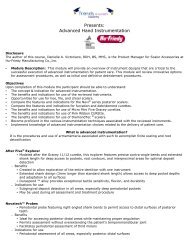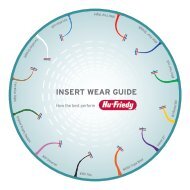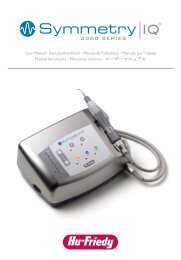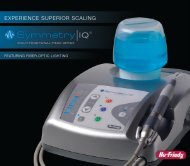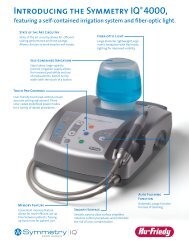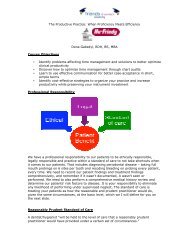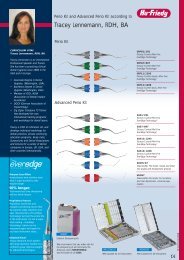Effective and Productive Instrument Processing - Friends of Hu-Friedy
Effective and Productive Instrument Processing - Friends of Hu-Friedy
Effective and Productive Instrument Processing - Friends of Hu-Friedy
Create successful ePaper yourself
Turn your PDF publications into a flip-book with our unique Google optimized e-Paper software.
waves above human audibility that result in the formation <strong>of</strong><br />
oscillating bubbles (cavitation) that then collapse <strong>and</strong> implode.<br />
Ultrasonic detergents are also available for use. More recently,<br />
some ultrasonic manufacturers have employed a new technology<br />
that uses a variable frequency as opposed to a fixed frequency in<br />
order to deliver reliable cavitation to all areas <strong>of</strong> the solution <strong>and</strong><br />
reduce the potential for hot spots that could weaken cleaning ability.<br />
Additionally, some manufacturers are using materials with<br />
antimicrobial activity in the interior chamber <strong>of</strong> the ultrasonic<br />
unit. Regardless <strong>of</strong> the ultrasonic unit selected, it is important to<br />
suspend the instruments in a basket in the ultrasonic bath, as laying<br />
them flat inside the bath can result in inadequate cleaning <strong>and</strong><br />
removal <strong>of</strong> debris. Also, refer to the manufacturer’s instructions<br />
on how much weight can been put in the ultrasonic, as it is very<br />
important not to overload the sterilizer. <strong>Instrument</strong>s should be<br />
either in cassettes or loose, do not b<strong>and</strong> your instruments together<br />
because they will not be as well cleaned. Ultrasonic baths also<br />
have timers, <strong>and</strong> instruments should remain in the bath for the<br />
full length <strong>of</strong> time recommended by the manufacturer. Enzymatic<br />
solutions should be changed every shift (at least daily) or more <strong>of</strong>ten<br />
if receiving heavy loads <strong>of</strong> contaminated instruments (degree<br />
<strong>of</strong> contamination <strong>and</strong> frequency <strong>of</strong> use are contributing factors in<br />
determining how <strong>of</strong>ten to change the ultrasonic solution).<br />
<strong>Instrument</strong> washers/disinfectors are a class <strong>of</strong> device traditionally<br />
used by central sterilization services such as those in hospitals.<br />
These medical devices wash, rinse <strong>and</strong> dry instruments, reducing<br />
the risk <strong>of</strong> pathogen transmission during subsequent instrument<br />
h<strong>and</strong>ling while processing. It is important to verify that the unit<br />
you are using has FDA clearance.<br />
Figure 7. Automated Cleaners<br />
<strong>Instrument</strong> examination<br />
Examine all instruments closely, checking for broken instruments,<br />
burs <strong>and</strong> debris. Remove an instrument from service if it is damaged.<br />
The preferred remedy when instruments do not come out <strong>of</strong><br />
the ultrasonic bath or automatic washer free <strong>of</strong> debris is to run the<br />
instrument again to remove the debris or soak it in a presoak. If<br />
h<strong>and</strong> scrubbing becomes necessary:<br />
• Scrub one instrument at a time with a long-h<strong>and</strong>led brush.<br />
• Do not scrub until the item has been run through a mechanical<br />
cleaner to remove as much organic matter as possible.<br />
• Hold the instrument down low in the sink, preferably under<br />
water, to reduce aerosol formation as much as possible.<br />
Tips for <strong>Instrument</strong> Cleaning <strong>and</strong> Examination<br />
• Presoaks <strong>and</strong> sprays prevent debris from drying or hardening on<br />
instruments.<br />
• Automated systems are the most effective <strong>and</strong> safest method <strong>of</strong><br />
decontamination.<br />
• Test your ultrasonic bath weekly.<br />
Preparing <strong>and</strong> packaging, custom containers, wraps<br />
After cleaning the instruments, it is critical to thoroughly rinse <strong>and</strong><br />
dry the instruments. Rinsing is essential to remove chemical <strong>and</strong><br />
detergent residues. This prevents spotting, pitting <strong>and</strong> staining <strong>of</strong><br />
instruments by detergents, which can interfere with the smooth<br />
operation <strong>of</strong> instruments. Splashing should be minimized during<br />
rinsing. Packaging cleaned, dried instruments prior to placing<br />
them in the sterilizer is a st<strong>and</strong>ard <strong>of</strong> care that protects instruments.<br />
Following sterilization, storing the instruments in the<br />
packaging maintains their sterility until they are required for use<br />
on patients. Unprotected instruments can be recontaminated with<br />
dust or spatter or by coming in contact with nonsterile surfaces<br />
during transport, storage <strong>and</strong> tray setup. 20 Packaging used must be<br />
FDA-cleared as a medical device to guarantee that the wrapping<br />
has been tested <strong>and</strong> is permeable to the chemical <strong>and</strong> steam. There<br />
are wraps available for every size <strong>of</strong> instrument. 21 Packaging is not<br />
reusable unless otherwise indicated, <strong>and</strong> includes plastic tubing,<br />
wrap, <strong>and</strong> plastic/paper pouches. In addition, color-coded instrument<br />
rings <strong>and</strong> cassette ID labels help organize instrument processing.<br />
When it is necessary to process loose instruments, these<br />
should be packaged so that they lie in a single layer, permitting<br />
exposure <strong>of</strong> all areas <strong>of</strong> the instruments to the sterilizing agent. To<br />
maintain integrity <strong>of</strong> the package, follow the manufacturer’s recommendations<br />
for sealing the package <strong>and</strong> do not use staples, pins<br />
or paper clips to seal packages. Do not overstuff packages.<br />
To maintain the integrity <strong>of</strong> packaging, follow the manufacturer’s<br />
instructions on sealing packages.<br />
The new CDC 2008 guidelines state that an internal <strong>and</strong> external<br />
indicator should be in each package. Companies now have<br />
pouches with both an internal <strong>and</strong> an external indicator. The dates<br />
<strong>and</strong> record <strong>of</strong> the sterilizer used if there is more than one in your<br />
practice, should be placed on the packaging. This is recorded so<br />
that if a positive spore test is obtained, all packages for the dates<br />
involved can be pulled.<br />
Figure 8. Packaging <strong>and</strong> Cassette<br />
www.ineedce.com 7


